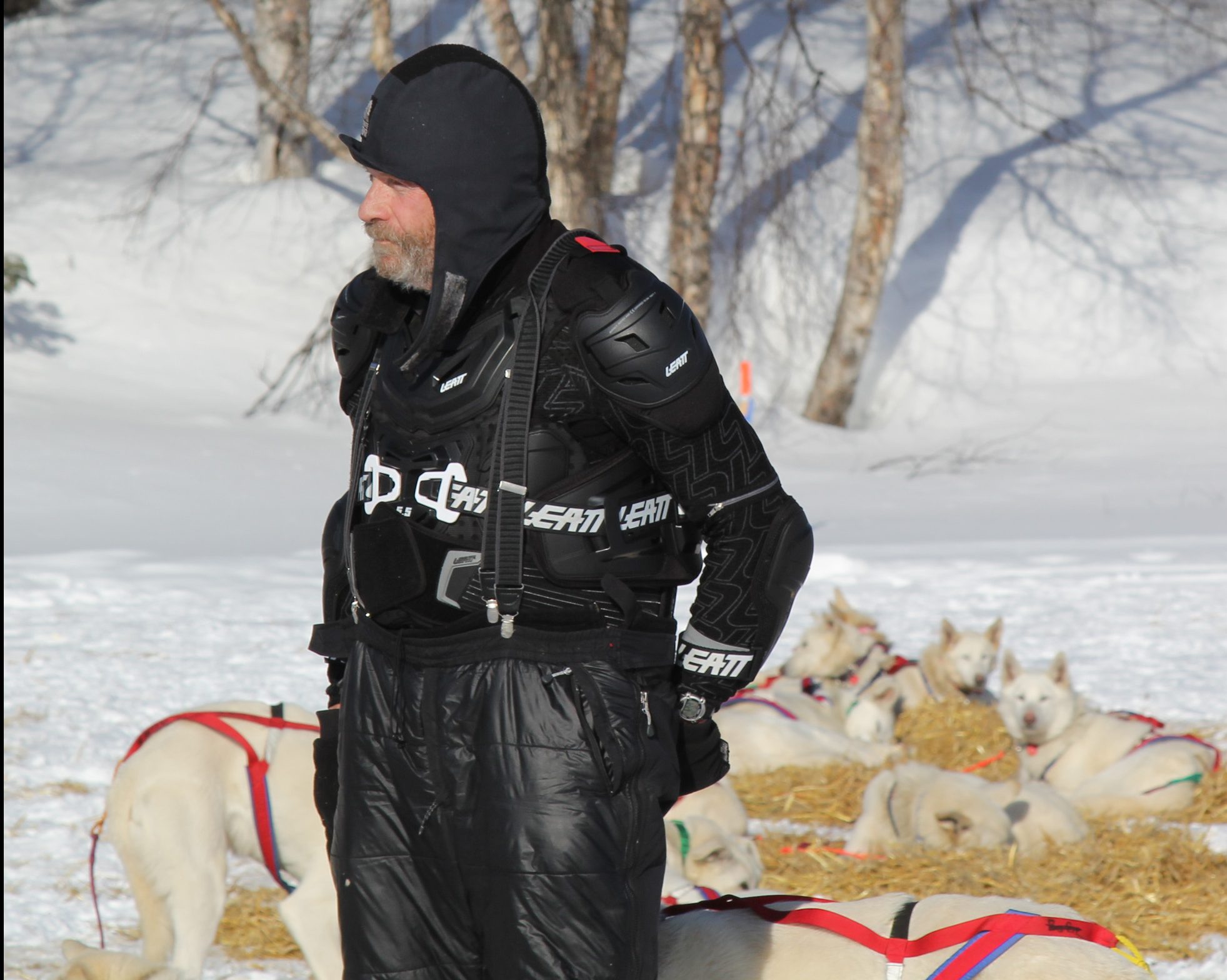
As the Iditarod route winds up the wooded hillsides of the Happy River Steps, toward the jagged mountains ringing frozen Pontilla Lake, they head through a narrow canyon toward the zig-zagging Dalzell Gorge. Even years later, the infamous 2014 conditions along the stretch have left a lasting impression on mushers – one that they bring specialty gear for.
Jim Lanier did become a 77-year-old musher by fooling around.
“Well, the thing is, it’s a contact sport,” Lanier said.
Standing in the sunshine with his team of ghostly white huskies at the Finger Lake checkpoint, Lanier is wearing what looks like a black, high-tech exoskeleton.
“It’s sort of full body armor,” Lanier said. “Neck to crotch I’m covered. And elbows and knees. I got it there, too.”
The gear is technically for mountain-bike racing, an upgrade from the hockey pads Lanier has worn in past years. The protective equipment is specifically for the hundred miles of trail through the Alaska Range, on past Rohn and into Nikolai. Lanier has broken enough bones in the course of his mushing career to dress with precaution in mind.
“It’s like the old bold pilot thing,” Lanier said. “There’s old pilots, and there’s bold pilots. But there’s no old, bold pilots. Same for mushers.”
Lanier’s hardly alone in treating this section of trail with extra reverence. One checkpoint ahead at Rainy Pass, Scott Jansen reaches into a drop-bag shipped up just for this particular part of the race, and pulls out a chest-protector meant for high-speed snowmachining.
“It’s all hard-sided, keep me from breaking some ribs. And then, I got my boy’s snowmachining helmet,” Jansen said. “I mean, better safe than sorry. I don’t want to hit my head and get knocked out of the race.”
In the 2014 race, when the downhill gorge was so icy there was no way to control dog teams as they charged over rocks and tree stumps, Jansen made it down relatively unscathed. But his luck ran out going through the Buffalo Tunnels on the way to Rohn.
“I crashed and got a concussion,” Jansen said. “About four hours later I broke through some ice, ran back to my sled, slipped on the ice, broke my foot.”
Jansen scratched that year. And the experience seriously affected him. He had bad anxiety in the two weeks before this year’s race, stuck in thoughts about the most brutal parts of the trail. That’s similar for Kelly Maixner, who in 2014 lead the pack down the gorge and was the first to make it to Rohn.
“It is a little bit of PTSD from that,” Maixner said. “Ya know, I think anytime you’re fearing for your life or anything – which at that point in time I was, because that was pretty nerve-wracking that year.”
Maixner did not pack extra protective gear this time around, largely because the snow conditions are vastly better. And because mushers were assured they wouldn’t face that degree of hazard again. An outcry after the 2014 race prompted the Iditarod to take extra precautions determining if areas of the trail were suitably safe.
From overhead, the thin ribbon of trail snaking through the gorge had plenty of snow, but also plenty of open water. Which could make for a soggy run out of the mountains.
Zachariah Hughes reports on city & state politics, arts & culture, drugs, and military affairs in Anchorage and South Central Alaska.
@ZachHughesAK About Zachariah




